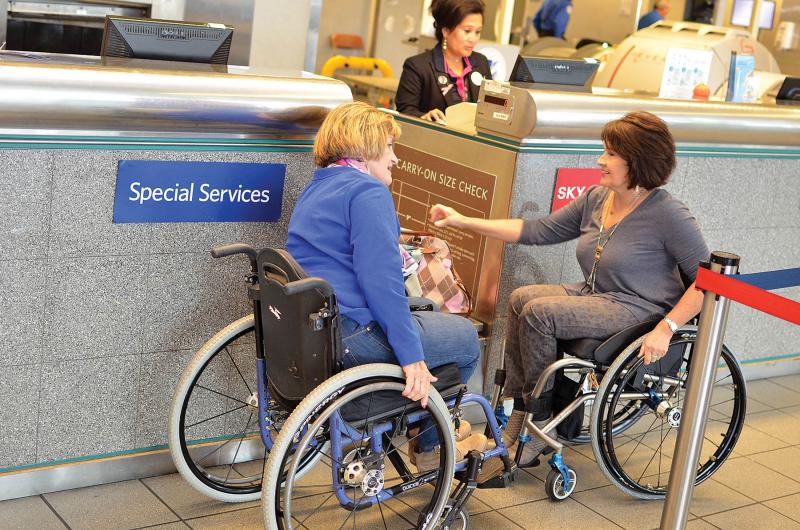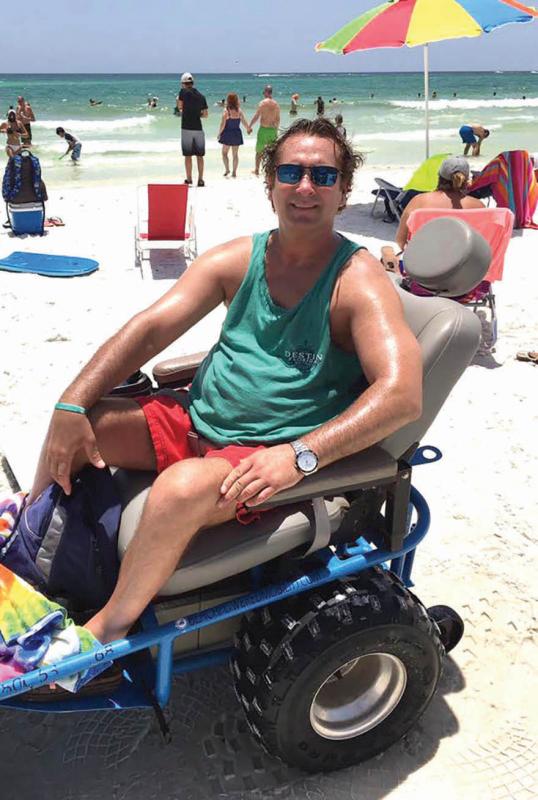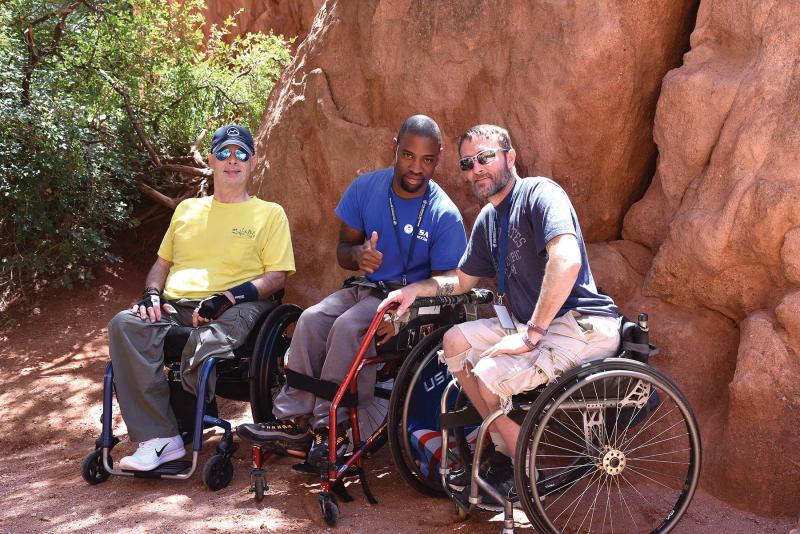As Sheila Burnham boarded a boat to go scuba diving in Belize, the Madison, Miss., resident could feel her fellow passengers doing double takes.
At the time, tourist destinations were hardly the domain of paraplegic wheelchair users.
“I was a novelty,” she said.
Today, she’s less of a spectacle as she hits the slopes in Colorado or hunts game in the wilds of Africa. Thanks to the Americans with Disabilities Act, more people than ever see the sights from the seat of a wheelchair.
But traveling with a disability is still no roll in the park.
“It takes a little planning and a lot of patience,” says paraplegic Karen Skeen of Madison, Miss., a research assistant at Methodist Rehabilitation Center in Jackson, Miss. “But you can’t let life pass you by just because you’re in a chair.”
Skeen said she understands why the newly injured are often nervous about travel. “I think it’s fear of the unknown that bothers most people,” she said.
So during regular group meetings with MRC’s spinal cord injury patients, she makes it a point to answer their questions and allay their concerns.
“If they can get their hands of information, it makes things a lot better,” she said. “I let them know what’s possible. My wheelchair doesn’t stop me.”
It also hasn’t limited paraplegic Joey Brinson of Florence, Miss., a member of Methodist Rehab’s wheelchair fencing squad and a veteran of the London and Rio de Janeiro Paralympic Games.
As an international competitor for the United States Wheelchair Fencing Team, Brinson has visited about 10 foreign countries. But despite his frequent flyer status, people are still surprised that he travels solo.
“They think somebody is supposed to be with you,” he said. “Especially in other countries, they want to know if you’re traveling alone.”
Readying for Take-Off
The ignorance surrounding wheelchair travel means Brinson, Burnham and Skeen often find themselves educating fellow passengers and transportation staff about the rights of people with disabilities.
Federal regulations require U.S. airlines to accommodate passengers with disabilities. And in 2009, the rule was expanded to include foreign flights in and out of the United States.
But Burnham said not all airport personnel are familiar with the rules. That’s why she always travels with a copy of the regulations. (Find them at www.transportation.gov/airconsumer/disability.)
The regulations address a number of issues, such as where wheelchair users will be seated, where their wheelchairs will be stored and what accommodations are available for bathroom breaks.
In certain instances, wheelchair users must give 48 hours notice before arriving at the airport and check in one hour in advance. But even when it’s not required, Burnham recommends arriving early and scheduling at least two hours for layovers.
“You are the first person on the plane and the last one off,” Burnham said. “And sometimes airport staff is not there with your wheelchair or someone to push you from place to place.”
One perk of flying with a wheelchair is you don’t have to wait in the security line, Skeen said. “Of course, they pat you down, but that doesn’t bother me,” she said.
Skeen said she does get annoyed when people misunderstand her capabilities. “You can’t reiterate enough that you are in a wheelchair because you cannot walk,” she said. “Sometimes they assume you can jump out of the chair.”
Another concern for wheelchair users is the nature of airline accommodations outside the United States.
Burnham said on a group dive trip to the Bahamas, “they had a machine lift us one by one onto the airplane.” And Brinson remembers a deplaning “fiasco” in Paris. “We got trapped on a mobile lift about three hours. I think they forgot about us,” he said.
While such events are frustrating, Brinson said it’s best to “go with the flow.”
“If you get impatient or rude, they put you to the side,” he said. “If you don’t argue with them, it goes better.”
When someone is ill-informed on disability rights, Burnham said she confronts them with the facts. “I learned very early that the Department of Transportation has a little yellow booklet for people with disabilities who are traveling by air,” she said. “So I just show them what’s in the yellow book.”
Once they’ve boarded, wheelchair users have to rely on narrow aisle chairs to move about. And since accessible toilets are only required for planes with more than one aisle, wheelchair users who can’t walk must devise back-up plans for bathroom breaks.
“I take a self-contained catheter kit with me whenever I travel,” Skeen said. “That way if I’m stuck on the tarmac or the plane is delayed, I can discretely catheterize myself under a blanket. And if it’s a long trip, you can get an in-dwelling catheter.”
Packing in general is a strategic process for wheelchair users, and Brinson says: “You never want to check everything on the plane. Stuff I would need if I got stranded is always with me.”
Such items include medications, health care supplies and items to trouble-shoot wheelchair breakdowns. “I take two extra inner tubes with me, just in case,” Skeen said.
Burnham said her carry-on luggage contains the back and seat of her wheelchair. “They come off, so I don’t want them to be lost,” she said.
Mobility equipment can be misplaced or damaged in transit, and it’s often the owners of expensive power wheelchairs who have the most problems. One recent social media post chronicled the experience of a man who had to put his power chair back together with zip ties after baggage handlers “trashed” the machine.
When an assistive device is lost, damaged or destroyed on a domestic flight, Department of Transportation regulations say “the criterion for calculating the compensation is the original purchase price of the device.”
However, the carrier may make note of any pre-existing defect to the device. That’s why many wheelchair owners take photos of their equipment with airline personnel before boarding flights.
Veteran travelers also recommend attaching instructions to power wheelchairs or scooters that detail how to disconnect batteries or disassemble the equipment. This is critical if the device must be taken apart to fit into cargo holds. Some owners also put their power chairs in manual mode so they can be pushed, rather than moved via the machine’s easily damaged joystick.
Once a plane has landed, request your personal wheelchair be brought to the gate, rather than the baggage area, advises Burnham. That avoids the hassle of depending on airport staff for transport. And as someone who regularly deals with her own luggage, Burnham said you’d be surprised how independent you can be.
“I’ve always flown by myself,” Burnham said. “I just hook my luggage to the front of my chair. I’m used to people staring at me.”
Accessibility on Land and Sea
When it comes to accessibility concerns, Burnham said airports aren’t the only place where the needs of wheelchairs users can be overlooked.
Burnham said hotel accommodations aren’t always as advertised. “Before I check in I say, ‘Give me a key,’ and I check the room. The controls for the air conditioning are never where they should be or the lip on a shower can keep you from getting in.”
To avoid such issues, Skeen does extensive research before reserving a room.
“It’s best to speak with a person at the hotel, not the main travel reservation line when you’re making plans,” Skeen said. “You can get them to describe the room and even measure the width of the door. You can also find out if they have a roll-in shower or if you’ll need a shower chair for your room.”
Skeen also does her homework while booking ground transportation. “You definitely have to plan ahead to arrange for a car or van rental that’s accessible,” she said. “But just about all major cities have rentals that hand controls can be added to.”
As for cruise travel, Burnham said most ships have already addressed the concerns of most wheelchair users. “They do disability better than the airlines,” she said.
One exception is the accessibility of the small boats that ferry passengers from ship to shore for excursions. Many don’t accommodate wheelchairs.
Beachfront venues often can be off-limits, too, as most wheelchair tires can’t get traction on sand. But some coastal communities have installed special surfaces for wheelchair traffic or begun renting beach-ready mobility devices. And there’s even a new water park in San Antonio specifically designed for people with disabilities.
As a result of such advances, Skeen said she was able to accompany her family to Pensacola just four months after she took a paralyzing tumble during a Mexican vacation. She hasn’t missed a beach outing since. “It’s so important to be with friends and family,” she said.
While Skeen used a manual wheelchair that required a companion to do the pushing, Johnny McGinn of Jackson, Miss., said he was recently able to rent a beach-ready power wheelchair in Destin, Fla.
“Instead of my family carrying me down to the beach, I could come and go as I pleased,” McGinn said. “I even played cornhole. Plus, I went about a mile and half to the grocery store to pick up things. I had so much more freedom.”
Burnham had the same feeling of independence during her first travel adventure post-injury, and she said the experience was empowering.
“When I got back home from Belize, I felt like my rehab was over,” she said. “I felt like I could do anything I set my mind to within reason.”



